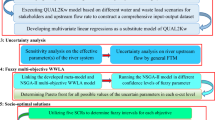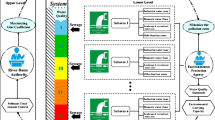Abstract
In this paper, a waste load allocation model is developed which can incorporate uncertainties due to randomness as well as vagueness regarding some variables and parameters. A probabilistic water quality index is also presented and used in the waste load allocation model. For any discharger of the system, different wastewater treatment scenarios are defined. All possible combinations of these scenarios make different wastewater treatment alternatives for the system. An optimization model having the objectives of minimizing total treatment cost as well as water quality violation risk is also developed for finding the optimum treatment alternatives. The uncertainty related to the upstream river flow is addressed through considering probability distribution functions with fuzzy parameters. To deal with fuzzy and random inputs, the fuzzy transformation technique and Monte Carlo analysis are respectively used, and for each alternative, fuzzy membership function of the violation risk is obtained. The optimization model only takes into account the economic and environmental objectives and does not specifically consider the stakeholders satisfaction. To consider this and help the decision maker choose a final alternative among non-dominated solutions, three different social choice procedures which focus on stakeholders priorities are employed. The applicability and effectiveness of the methodology are evaluated by applying it to the Zarjub River in Iran facing serious water quality issues. The results indicate that the presented methodology can effectively take account of priorities of various decision makers as well as economic and environmental considerations, while incorporating multiple forms of uncertainties.








Similar content being viewed by others
Abbreviations
- BOD5 :
-
5-Day biochemical oxygen demand
- DO:
-
Dissolved oxygen
- DOE:
-
Department of Environment
- FIS:
-
Fuzzy inference system
- IDOE:
-
Iran Department of Environment
- MSE:
-
Mean square error
- NO3 :
-
Nitrate
- NSGAII:
-
Non-dominated sorting genetic algorithm
- PDF:
-
Probability distribution functions
- PPRA:
-
Probabilistic pattern recognition algorithm
- PWQI:
-
Probabilistic water quality index
- RI:
-
Ranking index
- SC:
-
Social choice
- WLA:
-
Waste load allocation
- WQI:
-
Water quality index
References
Abed-Elmdoust, A., & Kerachian, R. (2012). Water quality management under incomplete information: application of an N-person iterated signaling game. Environmental Monitoring and Assessment, 184, 5875–5888.
Chen, S. M., & Wang, C. H. (2009). Fuzzy risk analysis based on ranking fuzzy numbers using α-cuts, belief features and signal/noise ratios. Expert Systems with Applications, 36, 5576–5581.
Cho, J. H., & Lee, J. H. (2014). Multi-objective waste load allocation model for optimizing waste load abatement and inequality among waste dischargers. Water, Air, and Soil Pollution, 225(3), 1–17.
d’Angelo, A., Eskandari, A., & Szidarovszky, F. (1998). Social choice procedures in water-resource management. Journal of Environmental Management, 52, 203–210.
De Borda, J. C. (1781). Mémoire sur les elections au scrutin. Paris: Historie de l’Axademie Royale des Sciences.
Deb, K., Pratap, A., Agarwal, S., & Meyarivan, T. (2002). A fast and elitist multiobjective genetic algorithm: NSGA-II. Evolutionary Computation, 6(2), 182–197.
Du, P., Li, Y. P., & Huang, G. H. (2013). Inexact chance-constrained waste-load allocation model for water quality management of Xiangxihe River. Journal of Environmental Engineering, 139(9), 1178–1197.
Ghosh, S., & Mujumdar, P. (2010). Fuzzy waste load allocation model: a multiobjective approach. Journal of Hydroinformatics, 12, 83–96.
Goetz, R. U., Martinez, Y., & Rodrigo, J. (2008). Water allocation by social choice rules: the case of sequential rules. Ecological Economics, 65, 304–314.
Guo, P., & Huang, G. H. (2009). Inexact fuzzy-stochastic mixed-integer programming approach for long-term planning of waste management—part A: methodology. Journal of Environmental Management, 91(2), 461–470.
Haghighi, A., & Zahdei Asl, A. (2014). Uncertainty analysis of water supply networks using the fuzzy set theory and NSGA-II. Engineering Applications of Artificial Intelligence, 32, 270–282.
Hanss, M. (2002). The transformation method for the simulation and analysis of systems with uncertain parameters. Fuzzy Sets and Systems, 130, 277–289.
Iran Department of Environment (2005). Developing pollution discharge permits in the Zarjub River basin. Technical Report.
Kerachian, R. (2012). Application of trading discharge permits for river water quality management. Technical report, Iran Water Resources Management Company.
Liu, D., Guo, S., Shao, Q., Jiang, Y., & Chen, X. (2014). Optimal allocation of water quantity and waste load in the Northwest Pearl River Delta, China. Stochastic Environmental Research and Risk Assessment, 28(6), 1525–1542.
Mahjouri, N., & Bizhani-Manzar, M. (2013). Waste load allocation in rivers using fallback bargaining. Water Resources Management, 9(3), 59–74.
Malakpour Estalaki, S., Abed-Elmdoust, A., & Kerachian, R. (2014). Developing environmental penalty functions for river water quality management: application of evolutionary game theory. Environmental Earth Sciences. doi:10.1007/s12665-014-3706-7.
Mamdani, E. H., & Assilian, S. (1975). An experiment in linguistic synthesis with a fuzzy logic controller. International Journal of Man–Machine Studies, 7, 1–13.
Mesbah, S. M., Kerachian, R., & Nikoo, M. R. (2009). Developing real time operating rules for trading discharge permits in rivers: application of Bayesian networks. Environmental Modelling and Software, 24, 238–246.
Mesbah, S. M., Kerachian, R., & Torabian, A. (2010). Trading pollutant discharge permits in rivers using fuzzy nonlinear cost functions. Desalination, 250, 313–317.
Morais, D. C., & de Almeida, A. T. (2012). Group decision making on water resources based on analysis of individual rankings. Omega, 40, 42–52.
Nikoo, M. R., Kerachian, R., Malakpour-Estalaki, S., Bashi-Azghadi, S. N., & Azimi, M. M. (2011). A probabilistic water quality index for river water quality assessment: a case study. Environmental Monitoring and Assessment, 181(1–4), 465–478.
Nikoo, M. R., Kerachian, R., & Niksokhan, M. H. (2012). Equitable waste load allocation in rivers using fuzzy bi-matrix games. Water Resources Management, 26, 4539–4552.
Nikoo, M. R., Kerachian, R., Karimi, A., & Azadnia, A. A. (2013). Optimal water and waste-load allocations in rivers using a fuzzy transformation technique: a case study. Environmental Monitoring and Assessment, 185, 2483–2502.
Nikoo, M. R., Kerachian, R., Karimi, A., Azadnia, A. A., & Jafarzadegan, K. (2014). Optimal water and waste load allocation in reservoir–river systems: a case study. Environmental Earth Sciences, 71(9), 4127–4142.
Niksokhan, M. H., Kerachian, R., & Amin, P. (2009). A stochastic conflict resolution model for trading pollutant discharge permits in river systems. Environmental Monitoring and Assessment, 154(1–4), 219–232.
Ocampo-Duque, W., Ferré-Huguet, N., Domingo, J. L., & Schuhmacher, M. (2006). Assessing water quality in rivers with fuzzy inference systems: a case study. Environment International, 32, 733–742.
Qin, X. S. (2012). Assessing environmental risks through fuzzy parameterized probabilistic analysis. Stochastic Environmental Research and Risk Assessment, 26, 43–58.
Rehana, S., & Mujumdar, P. (2009). An imprecise fuzzy risk approach for water quality management of a river system. Journal of Environmental Management, 90, 3653–3664.
Reynolds, A., Reilly, B., & Ellis, A. (2005). Electoral system design: the new international IDEA handbook. International Institute for Democracy and Electoral Assistance.
Sheikhmohammady, M., Kilgour, D. M., & Hipel, K. W. (2010). Modeling the Caspian Sea negotiations. Group Decision and Negotiation, 19(2), 149–168.
Tavakoli, A., Kerachian, R., Nikoo, M. R., Soltani, M., & Estalaki, S. M. (2014). Water and waste load allocation in rivers with emphasis on agricultural return flows: application of fractional factorial analysis. Environmental Monitoring and Assessment, 186(9), 5935–5949.
Wasserman, P. D. (1993). Advanced methods in neural computing (pp. 35–55). New York: Van Nostrand Reinhold.
Author information
Authors and Affiliations
Corresponding author
Rights and permissions
About this article
Cite this article
Mahjouri, N., Abbasi, MR. Waste load allocation in rivers under uncertainty: application of social choice procedures. Environ Monit Assess 187, 5 (2015). https://doi.org/10.1007/s10661-014-4194-7
Received:
Accepted:
Published:
DOI: https://doi.org/10.1007/s10661-014-4194-7




